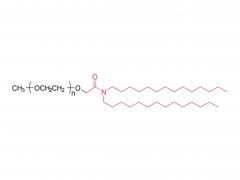Novel free-paclitaxel-loaded redox-responsive nanoparticles based on a disulfide-linked poly(ethylene glycol)-drug conjugate for intracellular drug delivery: synthesis, characterization, and antitumor activity in vitro and in vivo
Xingxing Chuan 1, Qin Song, Jialiang Lin, Xianhui Chen, Hua Zhang, Wenbing Dai, Bing He, Xueqing Wang, Qiang Zhang
To address the obstacles facing cancer chemotherapeutics, including toxicity, side effects, water insolubility, and lack of tumor selectivity, a novel stimuli-responsive drug-delivery system was developed based on paclitaxel-loaded poly(ethylene glycol)-disulfide-paclitaxel conjugate nanoparticles (PEG-SS-PTX/PTX NPs). The formulation emphasizes several benefits, including polymer-drug conjugates/prodrugs, self-assembled NPs, high drug content, redox responsiveness, and programmed drug release. The PTX-loaded, self-assembled NPs, with a uniform size of 103 nm, characterized by DLS, TEM, XRD, DSC, and (1)H NMR, exhibited excellent drug-loading capacity (15.7%) and entrapment efficiency (93.3%). PEG-SS-PTX/PTX NPs were relatively stable under normal conditions but disassembled quickly under reductive conditions, as indicated by their triggered-aggregation phenomena and drug-release profile in the presence of dithiothreitol (DTT), a reducing agent. Additionally, by taking advantage of the difference in the drug-release rates between physically loaded and chemically conjugated drugs, a programmed drug-release phenomenon was observed, which was attributed to a higher concentration and longer action time of the drugs. The influence of PEG-SS-PTX/PTX NPs on in vitro cytotoxicity, cell cycle progression, and cellular apoptosis was determined in the MCF-7 cell line, and the NPs demonstrated a superior anti-proliferative activity associated with PTX-induced cell cycle arrest in G2/M phase and apoptosis compared to their nonresponsive counterparts. Moreover, the redox-responsive NPs were more efficacious than both free PTX and the non-redox-responsive formulation at equivalent doses of PTX in a breast cancer xenograft mouse model. This redox-responsive PTX drug delivery system is promising and can be explored for use in effective intracellular drug delivery.
Keywords: paclitaxel; polymeric nanoparticles; polymer−drug conjugates/prodrugs; programmed drug release; redox-response.
Related products
Abbreviation: mPEG-SH
Name: Methoxypoly(ethylene glycol) thiol
Abbreviation: mPEG-PA
Name: Methoxypoly(ethylene glycol) propionic acid
For more product information, please contact us at:
US Tel: 1-844-782-5734
US Tel: 1-844-QUAL-PEG
CHN Tel: 400-918-9898
Email: sales@sinopeg.com





















